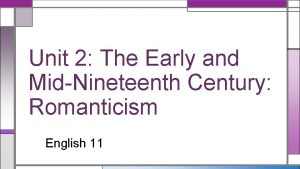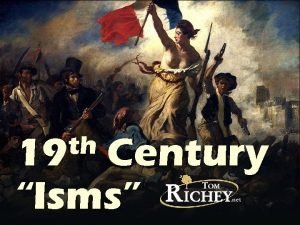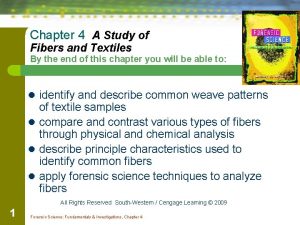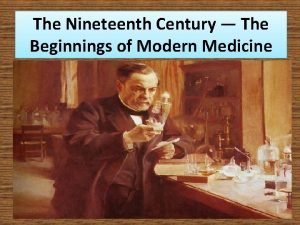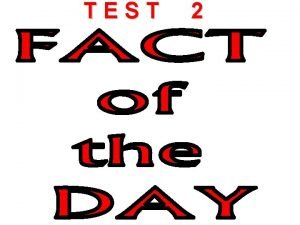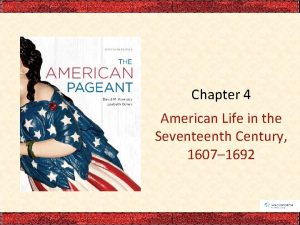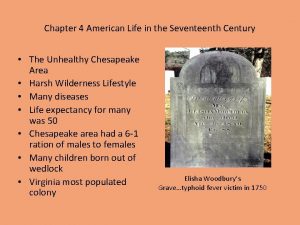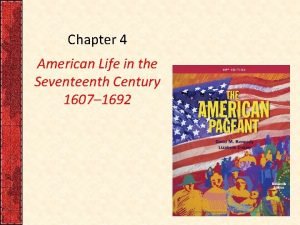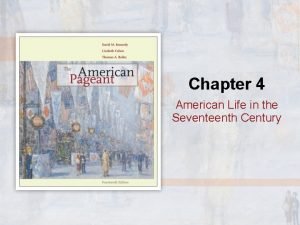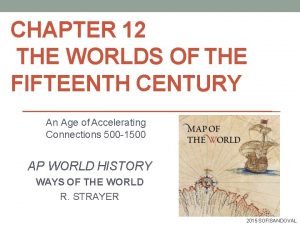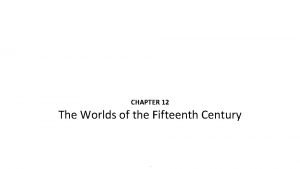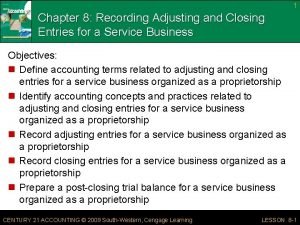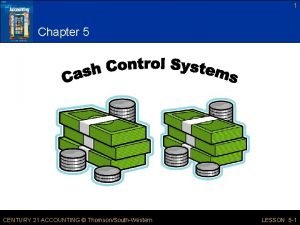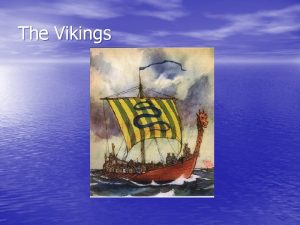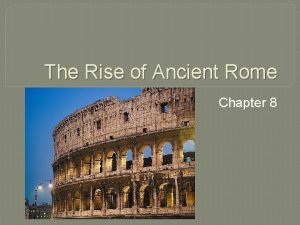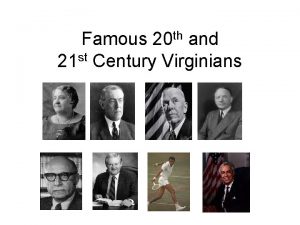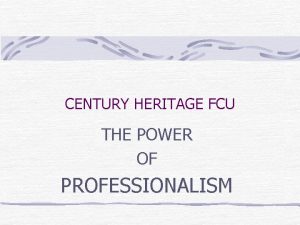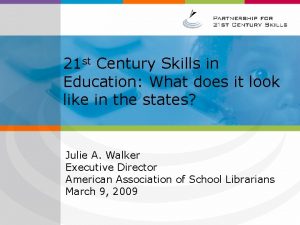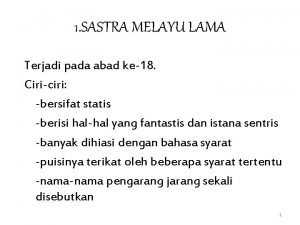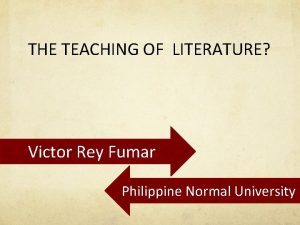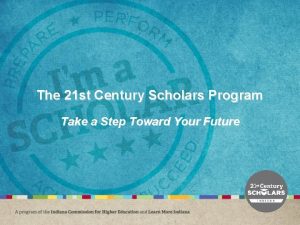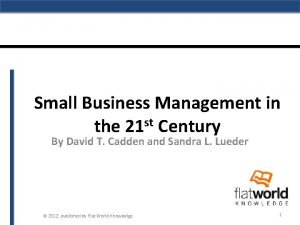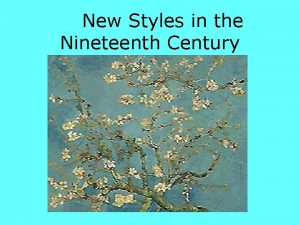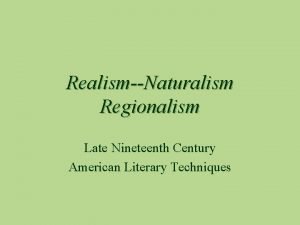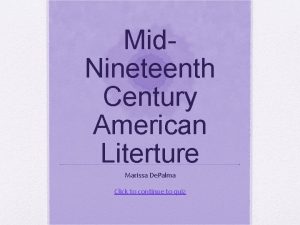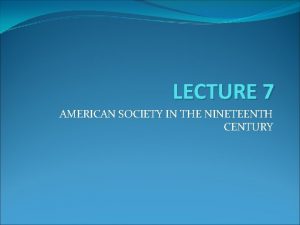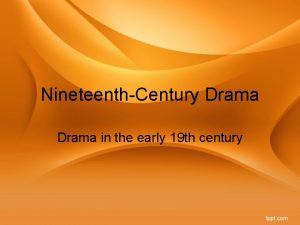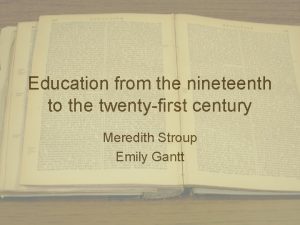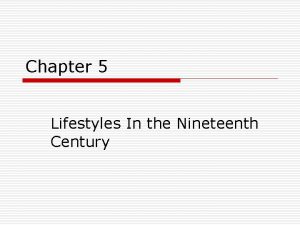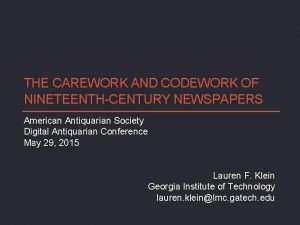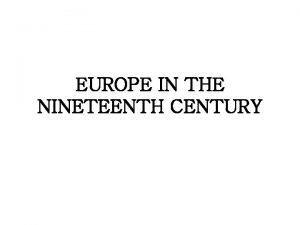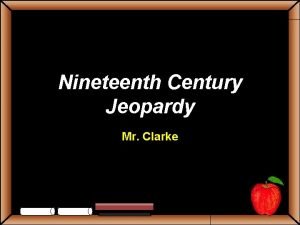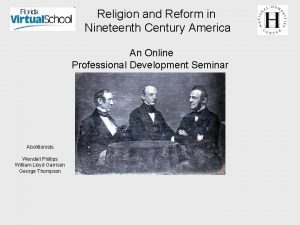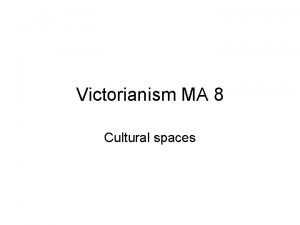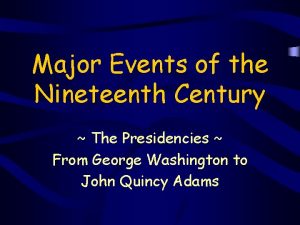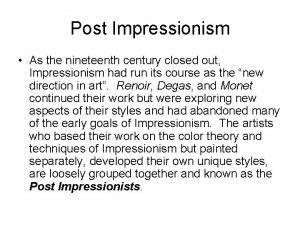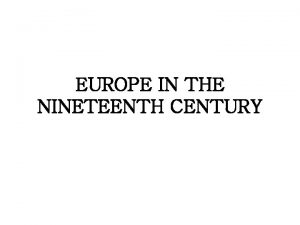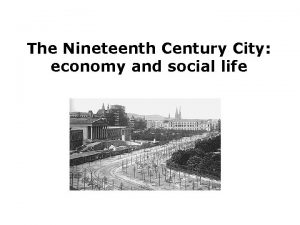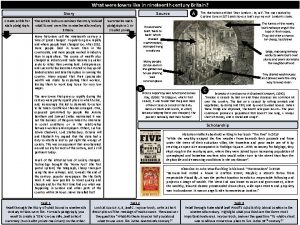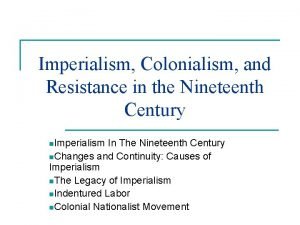Nineteenth Century American Education Chapter 21 NineteenthCentury American




























- Slides: 28

Nineteenth. Century American Education Chapter 21

Nineteenth-Century American Education • Education during the 19 th century set the ground work for the educational systems currently in place across the country today. There was a shift from religious control to state & government control of American education. The emphasis on universal public education, inclusion of immigrants, compulsory schooling, and tax supported education all influenced the establishment of common schools and higher education institutions.

Universal Education • Goal of universal education was to create literate citizens who were responsible individuals that would engage in civil service. This goal included the integration of diverse religious and ethnic groups as a means of establishing national unity and identity.

Universal Education Issues • Belief that education was a means of social • • advancement Belief in the social control theory- dominant groups would impose their beliefs and values on the lower socioeconomic class Dominant groups shaped curriculum Property owners opposed paying taxes Culturally diverse populations were afraid of losing their traditions and customs by conforming to common schools

Common Schools • Community institutions of elementary education • Advocates: Mann, Barnard, Carter, Edwards, Owens, & Stevens • American Lyceum Movement • Framework influenced by Prussian elementary school systems & Pestalozzianism

American Lyceum Movement • Lyceum- origin word Lyceus (location Greece) • • where Aristotle would lecture and teach his students Lyceum Movement- organized adult education forum: lectures, speeches, debates, instruction, dramatic performances National American Lyceum organization. Contributed significantly to adult education (new form of popular education); Ralph Waldo Emerson, Henry D. Thoreau, Abraham Lincoln, Susan B. Anthony, Mark Twain, Emma Hart Willard (supporter of Women’s Education)

American Lyceum Movement

Horace Mann (17961859) • Father of American • • common school Educated as a lawyer Secretary of Massachusetts Board of Education Congressman President of Antioch College

Mann’s Educational Philosophy • Individuals could achieve excellence through reasonable • • actions & respect for community and laws Encouraged upper class to contribute and support common schools Influenced by Transcendentalist philosophy- educating the masses for purposes of instilling morals and values and deemphasizing material objects; Supporter of Prussian educational systems Assimilation of immigrants into common schools Common schools should be governed by school boards and the public and should be supported by the state

Prussian Education System • Compulsory attendance • National testing • National curriculum • National teacher training • Mandatory Kindergarten • Skills for industrialized world & ethics and • discipline education http: //www. answers. com/topic/prussianeducation-system

Henry Barnard (1811 -1900) • Secretary of the State • • • Board of Commissioners of Common Schools in Connecticut Conservative philosophically and politically Supporter of economic individualism Supporter of improving teacher education

Common School Legislation • Tenth Amendment Constitution- education was • • • decentralized and states were granted authority over educational systems Allow school districts to function administratively and implement taxes Development of school districts & funding Compulsory and tax supported education

Secondary Education • Latin Grammar Schools • • upper preparatory classical curriculum Academy Schools- College prep courses, English courses, Teacher education courses (Military, Scientific, Commercial Academies); concerns with curriculum design & lack of universal accreditation system Academies were replaced by public high schools

th Women in the 19 Century • Early 19 th century- role of wife, mother, house • • keeper Childbearing (health concern) & high infant mortality rates concerns for women Late 19 th century- wife, mother, worked outside of home (labor/skilled workers), & consumers Reform: Woman’s Christian Temperance Movement & Women’s Suffrage Mary Wollstonecraft, Elizabeth Cady Stanton, & Susan B. Anthony

Women and Education in the 19 th Century • Public support of education for boys & girls • Belief- Women should be educated because • • • they raise children & moral companions of men (opposition of college education for women) College educated women often did not marry; Women treated unequally in Colleges Mind set-”The proper education of a man decides the welfare of an individual; but educate a woman, and the interests of a whole family are secured” Catherine Beecher http: //womenshistory. about. com/library/etext/bl _etext_index. htm

Initiatives for women • The first coeducational college established, Oberlin College, 1833. • First all women colleges, (first enduring) Vassar, 1861 and Bryn Mawr, 1880—first graduate school for women. • Yet in 1850 Antoinette Brown completed theology, but refused degree. (Oberlin)

Women continued • Significant women—a few more renowned: • 1840 s Elizabeth Blackwell first American woman • • • to receive a medical degree. South Carolina, Limestone Springs Female High School founded, 1845 “pioneering occurrence in the South. ” Elizabeth Palmer Peabody first English speaking kindergarten, Boston 1860 s. Maria Mitchell, Vassar, first woman admitted American to Academy of Arts and Sciences.

Women continued • Emma Hart Willard created beginnings of • • advanced ed for women with Middleburg Seminar for Women, Vermont. Her subsequent essay “A Plan for Female Education” influential in promoting cause of learning for women. 1875 six women elected to school committee by men and are allowed to vote on committee. By 1900 women represent 75 % of teachers

High Schools • High schools emerged as urbanization continued and their curriculum became much more focused on the industrial requirements rather than on the classics. State supported taxation for high schools came under attack in Michigan in 1874.

Colleges • Colleges were still following much of the familiar European structure calling for the classics and being primarily for religious purposes through the early portion of the century, but began to change to meet the changing economic, social and industrial requirement, especially with the Morrill acts.

Morrill Acts • Provided land the • sale/rental of which provided funds for the states to create universities. Morrill Acts-federal government required land grant colleges to provide military training, agricultural, and mechanical training • 1890 provided same opportunity to create colleges for African Americans.

Teacher Education & Normal Schools • During the 1830 s and 40 s normal school, originally two year institutions, were created for educating teachers. They were later expanded to three years and finally emerged as full four year degree granting universities.

African American Ed Milestones • 1840 s still illegal to teach slaves to read • 1849 Mass refuses Sarah Brown entrance to • • • public school & sets basis for Plessy v Ferguson — 1896) 1850 Cooper Union, NY first to ban admission based on race, religion, or color 1855 Massachusetts passes anti school segregation law 6 yrs too late for Brown 1860 s AA schools still segregated even in North —rundown buildings etc.

African American continued • 1860 s; Several black institutions emerge: • • • Howard University, Morehouse College, Fisk University, and Hampton Institute 1877 500, 000 black children in school in spite of southern efforts. 1881 Spelman College first Black Female Liberal Arts College founded 1883 Booker T. Washington founded Tuskeegee Institute

More African American • Fanny Jackson Coppin becomes Head of Institute • • for Colored Youth in Philadelphia and trains teachers to work in inferior schools provided for African American students. 1890 Second Morrill Land Grant Act passed established several Black land grant colleges 1896 Plessy v Ferguson Supreme Court rules for separate but equal, applied to schools, which remains until Brown v. Board of Education in 1954

Review of events of the 19 th century • Public elementary schools and high schools established • First time in 300 years ABC method not only method for teaching reading • Mc. Guffey reader introduced and is center of reading into 20 th century

References • http: //www. connerprairie. org/historyonline/1880 • • wom. html http: //womenshistory. about. com/library/etext/bl _vindication 000. htm http: //en. wikipedia. org/wiki/Horace_Mann • http: //www. yale. edu/ynhti/curriculum/units/1990/5/90. 0 5. 07. x. html • http: //www. answers. com/topic/prussianeducation-system • http: //en. wikipedia. org/wiki/Prussian_education_system

References • http: //members. aol. com/Alpha. Chautauquan/lyce • • um. html http: //womenhistory. about. com/od/work 19 th/ http: //en. wikipedia. org/wiki/Lyceum_movement http: //kclibrary, nhccd. edu/19 thcentury. html http: //members. aol. com/aacdcrnnea/lawtime. ht m
 The early and mid-nineteenth century: romanticism
The early and mid-nineteenth century: romanticism Nineteenth century isms review
Nineteenth century isms review Chapter 4 a study of fibers and textiles worksheet answers
Chapter 4 a study of fibers and textiles worksheet answers Nineteenth century
Nineteenth century Horace taylor the verdict september 25 1899
Horace taylor the verdict september 25 1899 Chapter 4 american life in the seventeenth century
Chapter 4 american life in the seventeenth century American life in the seventeenth century
American life in the seventeenth century Chapter 4 american life in the seventeenth century
Chapter 4 american life in the seventeenth century Chapter 4 american life in the seventeenth century
Chapter 4 american life in the seventeenth century Wild swans at coole techniques
Wild swans at coole techniques The worlds of the fifteenth century
The worlds of the fifteenth century Chapter 12 the worlds of the fifteenth century
Chapter 12 the worlds of the fifteenth century 8-1 application problem accounting answers
8-1 application problem accounting answers 5-1 work together p.128 answers
5-1 work together p.128 answers How to read a timeline
How to read a timeline Arial century
Arial century Map of where vikings travelled
Map of where vikings travelled Roman empire in first century
Roman empire in first century Famous virginians 21st century
Famous virginians 21st century Defining marketing for the 21st century
Defining marketing for the 21st century Adaptitude
Adaptitude Century ecosystem model
Century ecosystem model British empire 20th century
British empire 20th century St century
St century The restoration and 18th century literature
The restoration and 18th century literature Example of tanaga poem
Example of tanaga poem 21 first century scholars
21 first century scholars Small business management in the 21st century
Small business management in the 21st century Parker v 20th century fox
Parker v 20th century fox
